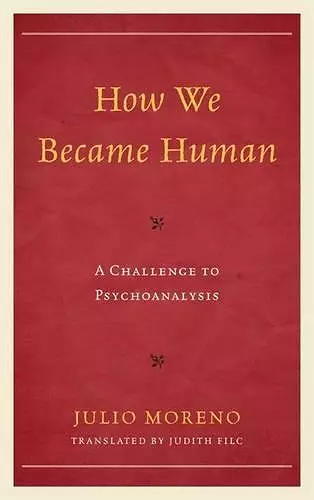How We Became Human
A Challenge to Psychoanalysis
Julio Moreno author Judith Filc translator
Format:Hardback
Publisher:Rowman & Littlefield
Published:6th Mar '14
Currently unavailable, and unfortunately no date known when it will be back

How We Became Human: A Challenge to Psychoanalysis tackles the question of what distinguishes human beings from other animals. By interweaving psychoanalysis, biology, physics, anthropology, and philosophy, Julio Moreno advances a novel thesis: human beings are faulty animals in their understanding of the world around them. This quality renders humans capable of connecting with inconsistencies, those events or phenomena that their logic cannot understand. The ability to go beyond consistency is humans’ distinctive trait. It is the source of their creativity and of their ability to modify the environment they inhabit. On the basis of this connective-associative interplay, Moreno proposes a new approach to the links human beings create amongst themselves and with the world around them. This theory focuses on a key question: What is the difference between human beings and the other animals? From this perspective, Moreno seeks to reformulate many of the classic psychoanalytic, psychological, and anthropological postulates on childhood, links, and psychic change.
This English translation of Moreno's idiosyncratic and demanding reading of what it means to be human, originally published in Spanish in 2002, will repay the Anglophone who makes the effort to follow its multiple trajectories of thinking. A psychoanalyst based in Argentina, Moreno covers an impressive terrain of ideas, all tied. . . .to the question of how humanness differs from animalness and how humans' understandings of their world are, in the end, faulty. Ranging across the disciplines of psychology, biology, philosophy, anthropology, and physics, Moreno situates the strengths and deficiencies of Freudian metapsychology. Students of psychoanalysis and psychology, especially those interested in problems related to child analysis and treatment, will find this book rewarding. Not a book easily compared with others, Moreno's speculative treatment of what is human about humans is an important contribution to the more generally defined, and growing, turn back to humanism. Summing Up: Recommended. Graduate students, researchers, faculty, professionals. * CHOICE *
This lucid and deep, simple and complex book raises a basic question: What is human about humans? Equipped with a solid training as a researcher and a psychoanalyst, Moreno daringly ties research from a variety of fields, from ethology to psychoanalysis, from logic to neurophysiology, from anthropology to computer science and virtual reality—resulting in a very broad outlook that How We Became Human encompasses in a careful and accomplished manner. -- Horacio Etchegoyen, MD, former president of the International Psychoanalytical Association
The Argentine psychoanalyst Julio Moreno has written an intellectual tour de force that is breathtaking in the scope of its knowledge and challenging in the complexity of its arguments. Starting from his unique view of what makes us human, Moreno returns to examine some of Freud’s basic assumptions and, from an entirely new perspective, sheds light on the clinical situation today. His book is essential reading for Freud scholars. -- Fred Busch, PhD, Psychoanalytic Institute of New England, East
Drawing with equal facility from his training in biophysics, neurobiology, and psychoanalytic practice, Julio Moreno deftly explores how we became human. The result is a richly entertaining book that makes for fascinating reading. Highly recommended. -- Antonino Ferro, MD, Italian Psychoanalytic Society
ISBN: 9781442228856
Dimensions: 237mm x 158mm x 21mm
Weight: 454g
210 pages